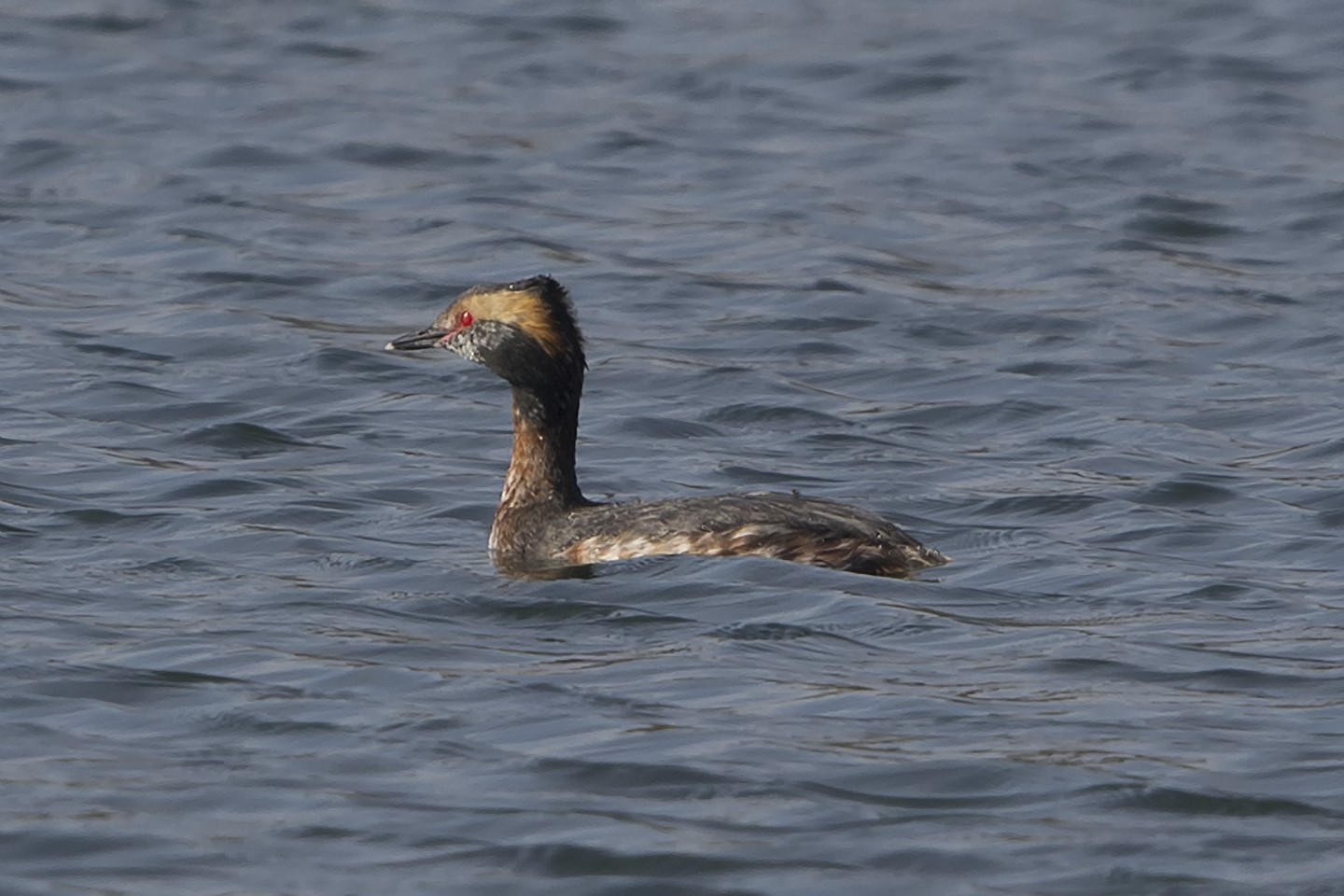Horned Grebe
A species of Typical Grebes Scientific name : Podiceps auritus Genus : Typical Grebes
Horned Grebe, A species of Typical Grebes
Botanical name: Podiceps auritus
Genus: Typical Grebes
Content
Description People often ask General Info
Description
Horned grebe can be easily recognised by its red-and-black alternate (breeding) plumage, its black-and-white basic (non-breeding) plumage and its characteristic "horns". It is 31–38 cm long, has a wingspan 55–74 cm wide and weighs 300–570 g. It has a moderately long neck, flat forehead and a rear crown of black feathers. Its beak is straight and pointy with a white tip. Both subspecies are physically similar, with P. a. auritus (Palearctic) appearing darker than P. a. cornutus (North America), which has light grey feathers on its back, which are inconspicuous or absent in P. a. auritus. The horned grebe is often confused with the black-necked grebe, which is similar in size and colouring but differentiates by a steeper forehead, a more slender bill and a fluffier rump. The alternate (breeding) plumage of the horned grebe has bright erectable "horns", black fan-shaped cheek feathers and an overall red-and-black colour. The neck, flanks, lores and upper-chest are chestnut brown, while the crown and back are black. The belly is a dull white. Males are slightly larger and brighter than females but are generally indistinguishable. The basic (non-breeding) plumage is overall black and white. The neck, chest and cheeks are white, while the back and crown are a dull black-grey. The border between the crown and the cheeks extend in a straight line behind the eyes. The basic plumage does not have the "horns". Juveniles appear similar to a non-breeding adult except they are a slightly duller shade of white and their back is tinged with brown. The line separating the cheeks and crown is less distinct and their beak is paler. The chicks are fluffy, with a dull grey back, a white belly and interesting black-and-white facial striping. 
Size
30-38 cm (12-15 in)
Colors
Brown
Black
Bronze
Gray
White
Orange
Life Expectancy
13 years
Nest Placement
Floating
Clutch Size
3 - 8 eggs
Incubation Period
1 brood
Number of Broods
23 - 24 days
Feeding Habits
Horned Grebe predominantly consume small fish, crustaceans, aquatic insects, and their larvae. They forage both at the water's surface and by diving to depths of around 20 feet. Horned Grebe exhibit agility underwater and may feed cooperatively in flocks. They also ingest feathers to filter fish bones during digestion, feeding solitary or in small groups, with dietary shifts between summer and winter.
Habitat
Horned Grebe are adaptable to a variety of wetland habitats, primarily in temperate to subarctic regions. They require small ponds with dense emergent vegetation for breeding. Larger lakes, rivers, and marshes serve as migration stopovers. In winter, they shift to coastal marine areas, estuaries, and bays, and can also inhabit artificial ponds.
Nest Behavior
Both male and female horned Grebe collaborate to select and construct the nest, as well as additional platforms for mating. Nest building coincides with the breeding season, and after construction, horned Grebe commence egg-laying. Both parents are involved in incubation and the care of their young.
Nest Characteristics
Horned Grebe create nests within 10 feet of the shore, often amid emergent vegetation. These nests are piles of aquatic plants, rising 2–4 inches above the water, measuring around 14–16 inches across with a central depression of about 4 inches for eggs. Some float and attach to vegetation, while others rest on rocks or soil, and some anchor to the pond bottom.
Dite type
Aquatic invertebrate eater
People often ask
General Info
Feeding Habits
Bird food type
Behavior
Horned Grebe exhibit monogamous pairings often established during migration or pre-breeding seasons. Upon reaching breeding grounds, pairs engage in intricate pair-bonding ceremonies involving synchronized movements and mutual weed offering. These displays extend to pre-copulation rituals. Their territorial instincts are pronounced near the nest, occasionally resulting in pseudo-colonial nesting due to space constraints. Both sexes invest equally in incubation and share responsibilities of feeding and defending the brood. Distinctively, parents may split brood care duties as chicks mature, leading to full independence by the fourth week after hatching.
Distribution Area
The Horned Grebe is distributed in Eurasia and North America. In Eurasia, it breeds in a few isolated locations in Greenland (uncommon), Iceland, Scotland and northwestern Norway, while extensively from southeastern Norway to western China. It winters along the coasts of Iceland, Norway and the British Isles down towards the Mediterranean, the Black Sea and the Caspian Sea. In eastern Asia, the Horned Grebe winters along the coasts of China, Korea and Japan. In North America, it is restricted to the northwestern region of the continent, with 92% of its distribution located in Canada. The total North American range spans from south-central Alaska to northwestern Ontario. It breeds as far north as the Yukon and southern Nunavut to northwestern states, from Washington to Minnesota. Additionally, there is a small population who breed annually on the Magdalene Islands of Quebec. Its wintering range is also primarily coastal from southern Alaska down to the northern Gulf of California. Its eastern overwintering range is from southern Nova Scotia, down to the Florida Keys and sometimes west to Texas. Horned Grebes breed primarily in temperate zones, including prairies and parklands, but are also seen in boreal and subarctic regions. They breed in small to moderately sized (0.5-10 ha) shallow freshwater ponds, marshes and shallow bays on lake edges with beds of emergent vegetation. They prefer areas with sedges, rushes, and cattails along with large areas of open water. This habitat provides a suitable site for nest material, anchorage, concealment and protection for young. During migration, they will stop along lakes, rivers and marshes. Following migration, they winter in marine environments of estuaries and bays or inland on large lakes, although in Norway, large concentrations congregate on inland lakes. 
Species Status
VULNERABLE. Uncommon to locally fairly common; declining throughout much of range.
